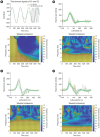Video Head Impulse Test Coherence Predicts Vertigo Recovery in Sudden Sensorineural Hearing Loss With Vertigo
- PMID: 39501570
- PMCID: PMC11626099
- DOI: 10.21053/ceo.2024.00068
Video Head Impulse Test Coherence Predicts Vertigo Recovery in Sudden Sensorineural Hearing Loss With Vertigo
Abstract
Objectives: Labyrinthitis significantly reduces quality of life due to prolonged vestibular symptoms in patients experiencing sudden sensorineural hearing loss with vertigo (SSNHLV). This study employed a novel coherence analysis in the video head impulse test (vHIT) to explore vertigo outcomes in SSNHLV patients.
Methods: A retrospective review was conducted on 48 SSNHLV patients who completed high-dose steroid treatment between December 2016 and April 2023. Additionally, 38 healthy volunteers were prospectively enrolled from November 2022 to April 2023 at our academic tertiary referral center. The magnitude-squared wavelet coherence between eye and head velocities during the vHIT was measured to assess correlations across frequency bands. Recovery from vertigo, determined by a visual analog scale (VAS) score of 0 at both 2 weeks and 2 months, was analyzed using multivariable Cox regression.
Results: The mean VAS for patients with SSNHLV was 5.73±2.45. Higher coherent frequencies in the horizontal semicircular canal (SCC), posterior SCC, and the mean and minimal coherent frequencies of all three SCCs combined were significantly associated with early complete remission of vertigo 2 weeks posttreatment. In the multivariate analysis, the minimal coherent frequency among the three SCCs emerged as an independent factor (hazard ratio, 2.040; 95% CI, 1.776-2.304). Two months posttreatment, in addition to the previously significant parameters, abnormalities in the vestibulo-ocular reflex (VOR) in the posterior SCC, gains in the horizontal and posterior SCCs, total and overt saccades in the horizontal SCC, coherent frequency in the anterior SCC, and mean VOR gain of all three SCCs combined were also statistically significantly related to total relief from vertigo.
Conclusion: The highest minimal coherent frequency among the three SCCs significantly contributed to earlier vertigo relief in patients with SSNHLV. Coherence analysis in vHIT may offer greater sensitivity than time series analysis for predicting the prognosis of vertigo.
Keywords: Sudden Sensorineural Hearing Loss; Vertigo; Video Head Impulse Test; Wavelet Coherence.
Conflict of interest statement
No potential conflict of interest relevant to this article was reported.
Figures



References
-
- Chandrasekhar SS, Tsai Do BS, Schwartz SR, Bontempo LJ, Faucett EA, Finestone SA, et al. Clinical practice guideline: sudden hearing loss (update) Otolaryngol Head Neck Surg. 2019 Aug;161(1_suppl):S1–45. - PubMed
-
- Park HM, Jung SW, Rhee CK. Vestibular diagnosis as prognostic indicator in sudden hearing loss with vertigo. Acta Otolaryngol Suppl. 2001 Jul;121(533):80–3. - PubMed
-
- Shaia FT, Sheehy JL. Sudden sensori-neural hearing impairment: a report of 1,220 cases. Laryngoscope. 1976 Mar;86(3):389–98. - PubMed
-
- Psifidis AD, Psillas GK, Daniilidis JC. Sudden sensorineural hearing loss: long-term follow-up results. Otolaryngol Head Neck Surg. 2006 May;134(5):809–15. - PubMed
-
- Carlsson PI, Hall M, Lind KJ, Danermark B. Quality of life, psychosocial consequences, and audiological rehabilitation after sudden sensorineural hearing loss. Int J Audiol. 2011 Feb;50(2):139–44. - PubMed
Grants and funding
LinkOut - more resources
Full Text Sources
Research Materials
Miscellaneous

